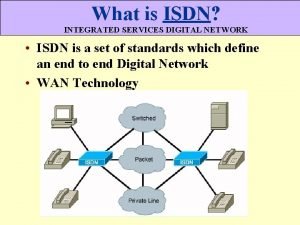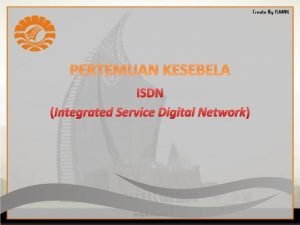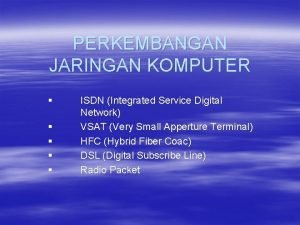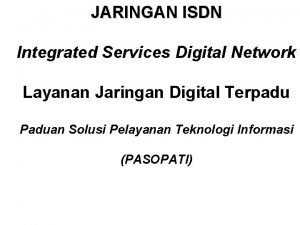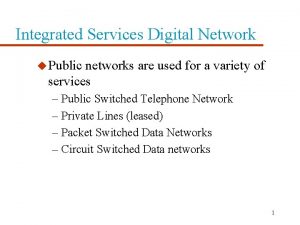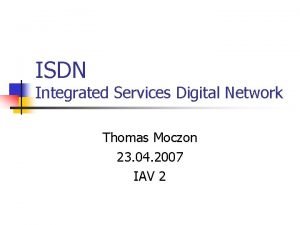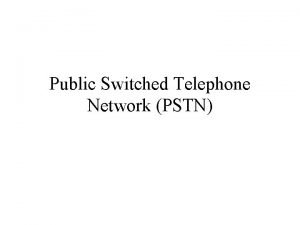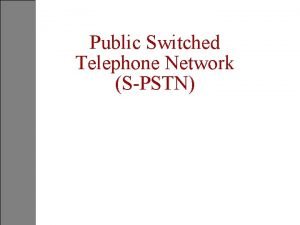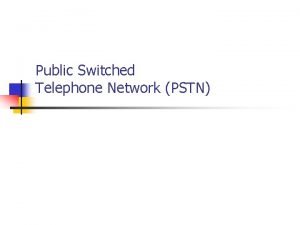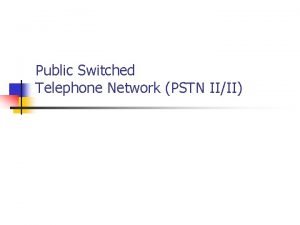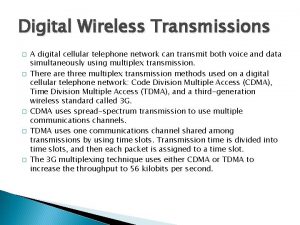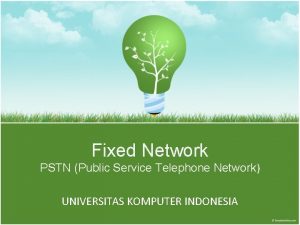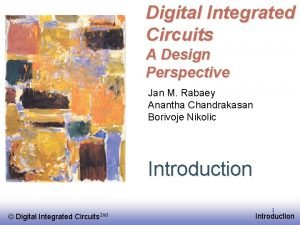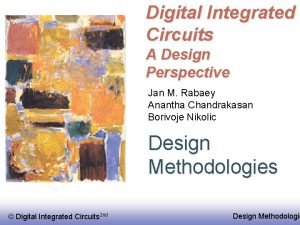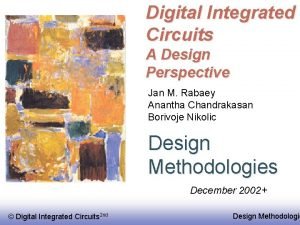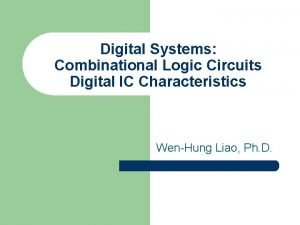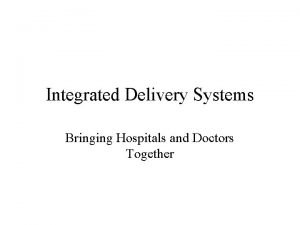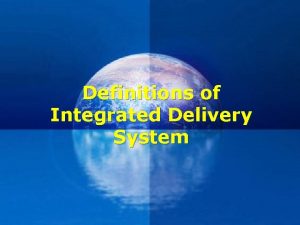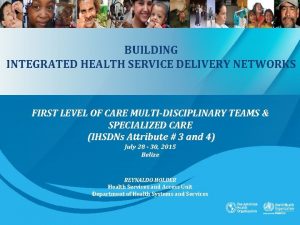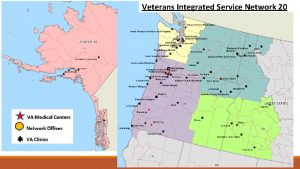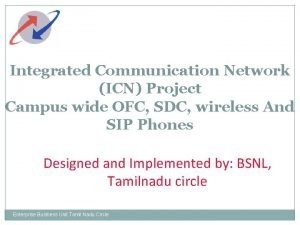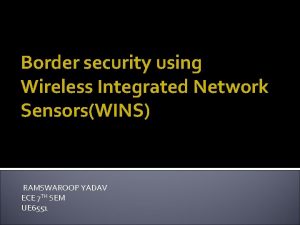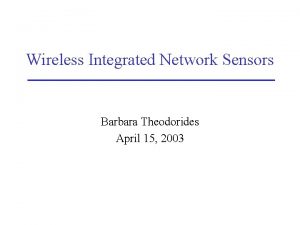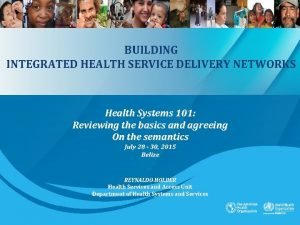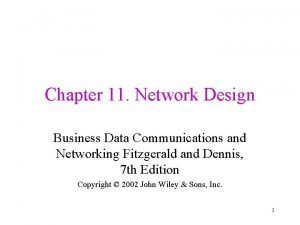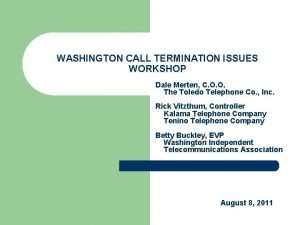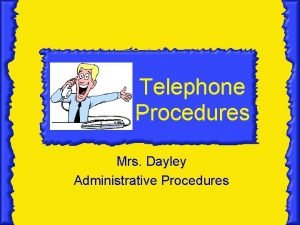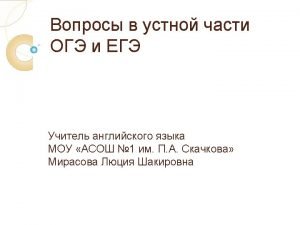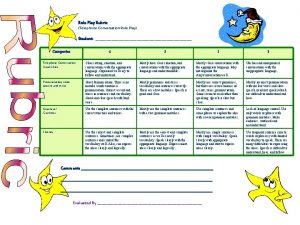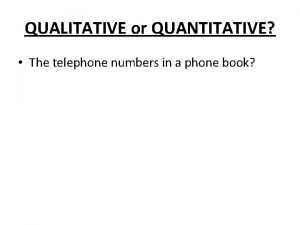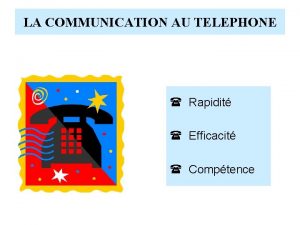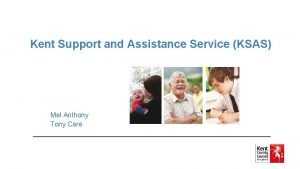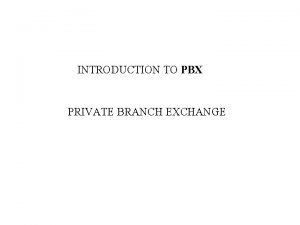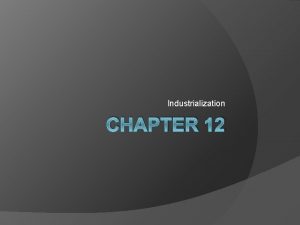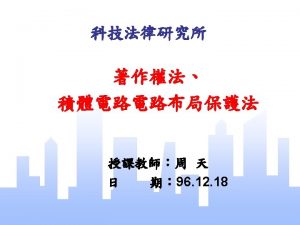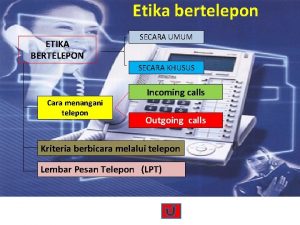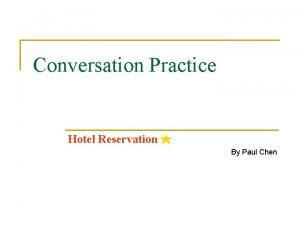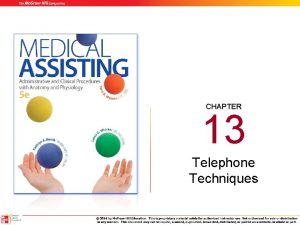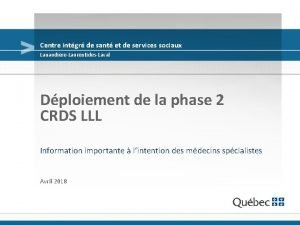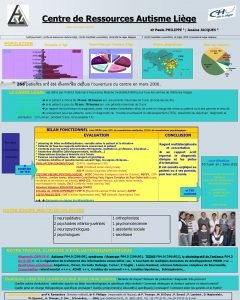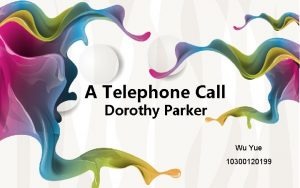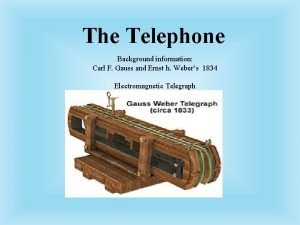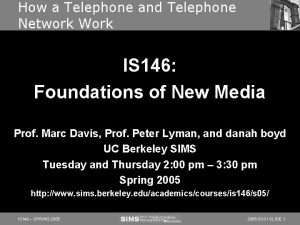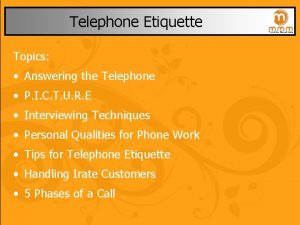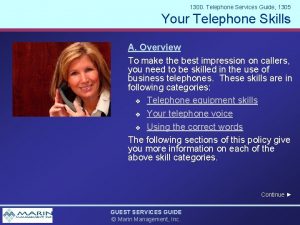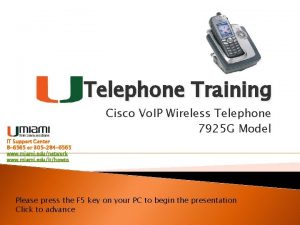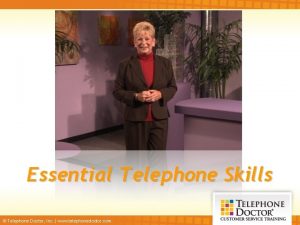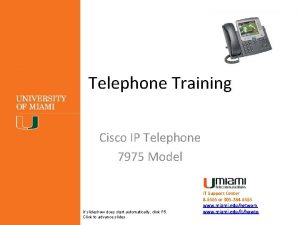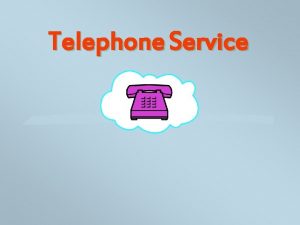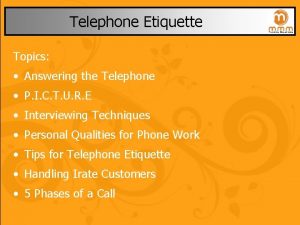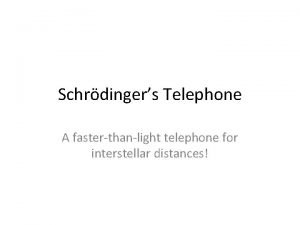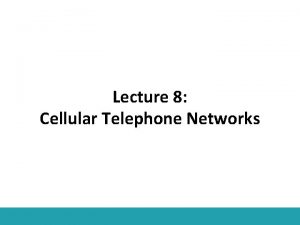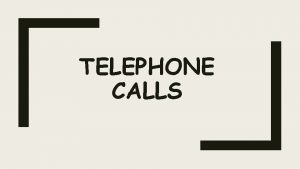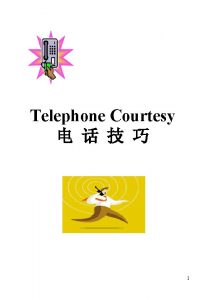Traditional Telephone Network VS Integrated Digital Network l
































































- Slides: 64

Traditional Telephone Network VS Integrated Digital Network l Traditional Telephone Networks ¡ Separately designed and administrated transmission and switching systems ¡ Demultiplexing and demodulating are necessary at each switching center ¡ A repeated process results in an accommodation of noise as well as cost l Integration of transmission and switching systems ¡ Achievable when both systems are digital ¡ Using PCM modulation and TDM multiplexing ¡ Switching without decoding along the way ¡ Separate multiplex/demultiplex channel banks are not required 1

Analog Communications w/o ISDN 2

The Integrated Digital Network Multiplex and modulate signals Space-division switch Demultiplex and demodulate signals Analog telephone network PCM: pulse-code modulation 3

Digital Communications with ISDN 4

The Integrated Digital Network (cont’d) l The IDN will combine the coverage of the geographically extensive telephone network with the data carrying capacity of digital data networks in a structure called the “integrated services digital network (ISDN)” ¡“integrated” refers to the simultaneous carrying of digitized voice and a variety of data traffic on the same digital transmission links and by the same digital exchanges 5

Principles of ISDN 1. Support of voice and non-voice applications using a limited set of standardized facilities ¡ Defines the purpose of ISDN and the means of achieving it 2. Support for switched and non-switched applications ¡ Both circuit-switched and packet-switched connections ¡ Support non-switched services in the form of dedicated lines 3. Reliance on 64 -kbps connections ¡ Fundamental block of ISDN ¡ 64 kbps were chosen because it was the standard rate for digitized voice 6

Principles of ISDN (cont’d) 4. Intelligence in the network ¡ Sophisticated serviced beyond simple setup a circuit-switched call ¡ Sophisticated network management and maintenance capabilities ¡ Use of SS 7 ( (common channel) signaling system number 7) and intelligent switching nodes in the network ¡ SS 7 is a set of telephony signaling protocols which are used to set up the vast majority of the world's public switched telephone network telephone calls. 5. Layered protocol architecture ¡ User access to ISDN protocol is a layered architecture that can be mapped to OSI model ¡ Standards can be developed independently for various layers and functions 6. Variety of configurations ¡ More than one physical configuration is possible for implementing ISDN 7

The User Interface 8

The User Interface (cont’d) l User has access to ISDN via a local interface to a digital “pipe”. l Pipes of various sizes are available to satisfy different needs l Pipe to the user’s promises has a fixed capacity but the traffic on the pipe may be a variable mix up to the capacity limit l ISDN requires control signals to instruct how to sort out the time-multiplexed data and provide the required services l Control signals are multiplexed onto the same digital pipe 9

The User Interface (cont’d) l Recommendation from I. 410: more than one size of pipe is needed ¡ A single terminal (e. g. a residential telephone) ¡ Multiple terminals (e. g. a residential telephone, PC, and alarm system) ¡ A network of devices attached to a LAN or PBX (ISDN gateway) 10

The User Interface (cont’d) 11

Benefits l The principle benefits of ISDN to the customer can be expressed in terms of cost savings and flexibility l Integrated voice and data means that the user does not have to buy multiple services to meet multiple needs ¡Access charges to a single line only ¡Purchasing services based on actual needs ¡Product diversity, low price, and wide availability of equipment 12

ISDN Architecture 13

ISDN Architecture (cont’d) l Physical interface provides a standardized means of attaching to the network l The interface supports a basic service consisting of three time-multiplexed channels, two at 64 kbps and one at 16 kbps l In addition, there is a primary service that provide multiple 64 -kbps channels l An interface is defined between the customer’s terminal equipment (TE) and a device on the customer’s premises, known as a network termination (NT) l The subscriber loop is the physical path from the subscriber’s NT to the ISDN central office ¡ Must support full-duplex digital transmission for both basic and primary data rates 14

Outline l ISDN Overview l ISDN Interfaces and Functions ¡ ISDN Standard ¡ Transmission Structure ¡ ISDN Model ¡ Reference Points and Functional Groupings ¡ Access Configurations ¡ ISDN Switch Types l ISDN Tutorial ¡ Network Diagram ¡ Type of Equipment ¡ Configuring your ISDN Line and Equipment ¡ Wiring your Location for ISDN 15

ISDN Standard 16

Transmission Structure l Digital pipe between central office and ISDN subscriber carry a number of communication channels, varies from user to user l The transmission structure of access links includes channels of: ¡ B channel: 64 kbps ¡ D channel: 16 or 64 kbps ¡ H channel: 384 (H 0), 1536 (H 11), or 1920 (H 12) kbps 17

B Channel l A user channel, carrying digital data, PCM-encoded digital voice, or a mixture of lower-rate traffic at a fraction of 64 kbps l The information is carried in frame format, using either high-level data link control (HDLC) or PPP as the Layer 2 protocol. PPP is more robust than HDLC because it provides a mechanism for authentication and negotiation of compatible link and protocol configuration. NETE 0510: Communication Media and Data Communications 18

D Channel l Carry common-channel signaling (CCS) information to control circuit-switched calls l Traffic over the D channel employs the Link Access Procedure on the D Channel (LAPD) protocol. LAPD is a data link layer protocol based on HDLC. l May be used for packet switching or low speed (e. g. 100 bps) telemetry (data transfer over media) when no signaling information is waiting 19

ISDN Channel Functions 20

H Channel l Provides user information transmission at higher data rates l Use the channel as a high-speed trunk or subdivide it based on TDM l Examples: fast fax, video, high-speed data, high quality audio 21

Basic and Primary Channel Structures 22

ISDN Model 23

ISDN Protocols at the user-network interface 24

ISDN Physical Layer l Each ISDN BRI frame contains two sub-frames each containing the following: ¡ 8 bits from the B 1 channel, 8 bits from the B 2 channel, 2 bits from the D channel, and 6 bits of overhead l So, each BRI frame contains 48 bits 25

ISDN Physical Layer (cont’d) l The overhead bits of an ISDN sub-frame are used as follows: ¡ Framing bit — Provides synchronization ¡ Load balancing bit- Adjusts the average bit value ¡ Echo of previous D channel bits — Used for contention resolution when several terminals on a passive bus contend for a channel ¡ Activation bit — Activates devices ¡ Spare bit — Unassigned 26

ISDN Physical Layer (cont’d) l 4, 000 frames are transmitted per second. l Each B channel, B 1 and B 2, has a capacity of 8 * 4000 * 2 = 64 kbps, while channel D has a capacity of 2 * 4000 * 2 = 16 kbps. l This accounts for 144 kbps (B 1 + B 2 + D) of the total ISDN BRI physical interface bit rate of 192 kbps. l The remainder of the data rate are the overhead bits that are required for transmission: 6 * 4000 * 2 = 48 kbps. 27

ISDN Data-link Layer SAPI identifies the portal at which LAPD services are provided to Layer 3 28

ISDN Data-link Layer (cont’d) l Layer 2 of the ISDN signaling channel is LAPD is similar to HDLC. LAPD is used across the D channel to ensure that control and signaling information is received and flows properly. l The LAPD flag and control fields are identical to those of HDLC. l The LAPD address field is 2 bytes long. ¡ The first address field byte contains the service access point identifier (SAPI), which identifies the portal at which LAPD services are provided to Layer 3. The command/response bit (C/R) indicates whether the frame contains a command or a response. ¡ The second byte contains the terminal endpoint identifier (TEI). 29

ISDN Layer 3: Q. 931 Messaging Call Setup 30

(Q. 931 Messaging Call Setup) NETE 0510: Communication Media and Data Communications 31

Reference Points and Functional Groupings l ITU-T approach for actual user’s physical configuration ¡Functional grouping: certain arrangements of physical equipment or combination of equipment l. NT 1, NT 2, TE 1, TE 2, TA ¡Reference points: conceptual points of separation of group function l. R, S, T, U 32

Functional Groupings l NT 1 (Network Termination 1) ¡ Includes functions similar to OSI layer 1 ¡ May be controlled by ISDN provider (a boundary to network) ¡ Isolate the user from the transmission technology of subscriber loop ¡ Supports multiple channels (e. g. 2 B+D) using TDM ¡ Might support multiple devices in a multidrop arrangement l E. g. a residential interface might include a telephone, PC, and alarm system, all attached to a single NT 1 interface via a multidrop line 33

Functional Groupings (cont’d) l NT 2 (Network Termination 2) ¡ An intelligent device that may include up to OSI layer 3 ¡ Perform switching and concentration functions l Switching: the construction of a private network using semipermanent circuit among a number of sites l Concentration: multiple devices, attached to a digital PBX, LAN, or terminal controller, may transmit data across ISDN ¡ E. g. digital PBX, a terminal controller, LAN l Digital PBX provides NT 2 functions at layers 1, 2, and 3 l A simple terminal controller provides layers 1 and 2 l A simple Time Division MUX provides layer 1 34

Functional Groupings (cont’d) l TE 1 (Terminal Equipment type 1) ¡ Devices that support the standard ISDN interface ¡ E. g. digital telephone, integrated voice/data terminal, digital fax l TE 2 (Terminal Equipment type 2) ¡ The existing non-ISDN equipment ¡ E. g. physical interface RS-232, host computer with X. 25 ¡ Requires a terminal adaptor (TA) to plug into an ISDN interface 35

Functional Groupings (cont’d) l TA (Terminal Adaptor) ¡ Converts standard electrical signals into the form used by ISDN ¡ Needed for connection with TE 2 devices ¡ The ISDN TA can be either a standalone device or a board inside the TE 2 36

Reference Points and Functional Groupings 37

Reference Points l Reference point R (connect TE 2 -TA) ¡ Provides a non-ISDN interface between user equipment that is non-ISDN compatible and adaptor equipment ¡ Comply with X or V series ITU-T recommendation l Reference point S (connect TE 1 -NT 2, TA-NT 2) ¡ The interface of individual ISDN terminals ¡ Separate user terminal from network communications functions l Reference point T (connect NT 2 -NT 1) ¡ A minimal ISDN network termination at CPE ¡ Separate network’s provider equipment from the user’s one l Reference point U (connect NT 1 -provider) ¡ Describes full-duplex data signal on the subscriber line 38

Access Configurations l Based on definitions of functional grouping and reference points, several possible configurations for ISDN user-network interface have been proposed by ITU-T ¡ The most straightforward configuration is that one or more pieces of equipment correspond to each functional grouping: 39

Access Configurations (cont’d) l In second case, the line termination function is combined with other ISDN interface functions l ISDN provider may provide the NT 1 function e. g. NT 1 may be integrated into a PBX 40

Access Configurations (cont’d) l In the third case, NT 2 and TE functions are combined l A host that supports users, but also acts as a packet switch in a private packet-switching network that uses ISDN for trunking 41

Access Configurations (cont’d) l Final case: an ISDN subscriber device can connect directly to the subscriber loop terminator or into a PBX or LAN using the same interface specifications and thus ensuring portability 42

Examples of implementation of NT 1 and NT 2 functions 43

Examples of implementation of NT 1 and NT 2 functions 44

NT 1 equipment NT 1 circuit card 45

ISDN Switch Type l Routers must be configured to identify the type of switch with which they will communicate. l Available ISDN switch types vary, depending in part on the country. As a consequence of various implementations of Q. 931, the D channel signaling protocol used on ISDN switches varies from vendor to vendor. l Each switch type operates slightly differently, and has a specific set of call setup requirements. l Before the router can be connected to an ISDN service, it must be configured for the switch type used at the CO. 46

ISDN Switch Type (cont’d) 47

Network Diagram 48

Types of Equipment Network Termination Device 1 (NT 1) l The NT 1 is a simple device that serves as an interface between the ISDN BRI line and your other ISDN equipment. l It converts the physical wiring interface delivered by Southwestern Bell to the wiring interface needed by your ISDN equipment, and also provides a testing point for troubleshooting. l Many ISDN terminal adapters and some ISDN routers have the NT 1 function built-in. This makes for an easier installation and also reduces the total cost of your ISDN setup. However, a separate NT 1 is more flexible in that it can support multiple ISDN devices. 49

Types of Equipment (cont’d) ISDN Routers l Perform a function similar to that of a standard router. l Using an ISDN router, multiple computers on a LAN can share a single ISDN BRI connection. l Because ISDN routers use Ethernet connections, they can take full advantage of ISDN's speed. l Many of the most popular ISDN routers also support analog voice, modem, or fax applications, as well as sophisticated network management capabilities. l ISDN routers are typically more than twice as expensive as TAs, but they are often worth the money since they allow multiple computers on a small LAN to leverage your ISDN investment. 50

Physical Interfaces l U-Interface ¡ The U-interface is the 2 -wire interface your phone company delivers for connection to the NT 1. ¡ Many of the newer ISDN networking devices, e. g. the 3 Com Impact, include a built-in internal NT 1 and power supply, so they can connect directly to the U-interface. ¡ Manufacturers may describe this feature as a "built-in NT 1 " or simply as a U-Interface ISDN TA. l S/T Interface ¡ The S/T-interface is the 4 -wire interface between the NT 1 and the ISDN networking equipment such as an ISDN TA or router. ¡ An S/T interface is used when the NT 1 is a separate device. 51

Physical Interfaces (cont’d) l Other interfaces ¡ The interface between your ISDN networking equipment and your computer is usually one of the standard industry interfaces. ¡ For example, an External TA will use the computer's serial COM port such as RS 232. ¡ ISDN routers will use a standard Ethernet connection, either directly to a computer's NIC card or via an intermediary Ethernet hub. 52

Configuring your ISDN Line and Equipment l Switch Type l ISDN Phone Number (Directory Number) l SPID (Service Profile Identifier) l TID (Terminal Identifier) 53

Switch Types l The "engines" of the ISDN phone network are the complex network switches which deliver the service. There are two dominant switches that provide ISDN: Lucent Technology's 5 ESS and Northern Telecom's DMS 100. l While those two switches provide the same basic features and functionality, they differ in how they interact with your ISDN equipment. l It is important that you find out which switch type and which software version will be providing you with ISDN service, so you can order your ISDN service and set your ISDN networking equipment parameters correctly. 54

Switch Types (cont’d) l In Southwestern Bell Internet Services territory, the possible switches and software versions are: ¡ Lucent Technology (formerly a part of AT&T) 5 ESS - NI 2 (National ISDN version 2) and/or AT&T custom ISDN software ¡ Northern Telecom DMS 100 - Custom ISDN software ¡ Northern Telecom DMS 100 - NI 1 (National ISDN version 1) software 55

ISDN Phone Number l Your ISDN phone line will be assigned a phone number just like a standard phone line. l However, depending on which kind of switch you are served from and how you are going to use the ISDN service, you may get one phone number per ISDN line or one phone number for each ISDN B-channel. l It is important for you to define how you plan to use your ISDN line so Southwestern Bell can assign the correct number of phone numbers. 56

ISDN Phone Number (cont’d) l DMS 100 ¡ A DMS switch always assumes a multipoint configuration. ¡ If you are served from a DMS-100 switch, you should receive two phone numbers, one for each B-channel. l 5 ESS ¡ If you receive your ISDN service from a 5 ESS switch, you need to choose either a "point-to-point "or "multipoint "configuration. ¡ If you only intend to connect a single device/application to your ISDN line, then you only need the point-to-point configuration. ¡ With the point-to-point configuration you are assigned a single phone number per ISDN line (not one for each B-channel). ¡ If you intend to connect multiple devices/applications, then you need the multipoint configuration. ¡ With multipoint configuration you are assigned a phone number for each device connected. 57

SPIDs l The ISDN carrier provides a SPID to identify the line configuration of the ISDN service. l SPIDs are a series of characters (that can look like phone numbers with extra digits) that identify you to the switch at the CO. After you're identified, the switch links the services you ordered to the connection. l However, depending on which kind of switch you are served from and how you are going to use the ISDN service, you may not need a SPID or you may need a SPID for each B-channel, or each device. l It is important for you to define how you plan to use your ISDN line so Southwestern Bell can assign the correct number of SPIDs. 58

SPIDs l DMS 100 ¡ You should receive two SPIDs, one for each B-channel. l 5 ESS ¡ Need to choose either a "point-to-point "or "multipoint " configuration. ¡ If you only intend to connect a single device/application to your ISDN line, then you only need the point-to-point configuration and you are not assigned any SPIDs. ¡ If you intend to connect multiple devices/applications, then you need the multipoint configuration. ¡ With the multipoint configuration you are assigned a SPID for each device connected. 59

TID l Specific to a National ISDN-1 BRI line from a DMS 100 switch, is the need for a terminal identifier (TID). l The TID is comprised of two additional digits used in conjunction with the SPID when initializing devices. l The TID is intended for use on all non-initializing terminals. l All terminals in use today are initializing terminals, and most do not require a specific TID. l To minimize confusion, it is recommended that you use "00" on each terminal device, no matter how many terminal devices there are. l For further clarification, you should check with your ISDN equipment vendor for their recommendation. 60

Wiring your Location for ISDN: Inside Wiring l By regulation, Southwestern Bell ISDN service ends at what is called the demarcation point ("demarc") usually just outside your residence or in an apartment building basement. l You are responsible for the wiring from the demarcation point to your ISDN equipment including the wall jacks. l You will want your ISDN phone jacks close to your ISDN equipment for the best performance. l You can choose to have Southwestern Bell install and maintain this "inside wiring" for an additional charge, or you can use an electrical contractor. 61

Wiring your Location for ISDN: Inside Wiring (cont’d) l While some homes and offices may need to be re-wired for ISDN, most will not. l The copper twisted pair wiring that currently provides standard analog phone service can be successfully used for ISDN. l However, with the increasingly popularity of multiple lines you may not have spare wiring available for your ISDN service. Therefore, additional cabling may be necessary. 62

Wiring your Location for ISDN: ISDN Phone Jacks l RJ 11 ¡ This is the standard analog phone jack, and is used to deliver 2 wire service. ¡ The phone company will often install this jack for ISDN unless otherwise requested. ¡ However, some NT 1 s required the wider RJ 45 or SJA 11 C jack. ¡ The 3 Com Impact phone cable has an RJ 11 plug on one end to connect to a RJ 11 wall jack. l RJ 45 ¡ Slightly wider than the RJ 11, and has 8 pins but can still be used to deliver 2 -wire service such as ISDN BRI. ¡ Again, some NT 1 s require this jack and their associated connecting cable with the RJ 45 plug will not fit into an RJ 11 jack. 63

Wiring your Location for ISDN: ISDN Phone Jacks (cont’d) l SJA 11 ¡ This is identical to the RJ 45 jack, but is a non-regulated product and therefore is significantly less expensive than the RJ 45. ¡ Specifically request this jack when ordering your ISDN service. 64
 The digital network
The digital network Isdn internet
Isdn internet Isdn komputer adalah
Isdn komputer adalah Isdn pra
Isdn pra Integrated digital services network
Integrated digital services network Ntba wiki
Ntba wiki Public switched telephone network diagram
Public switched telephone network diagram Spstn
Spstn Public switched telephone network diagram
Public switched telephone network diagram Pstn hierarchy
Pstn hierarchy A satellite used in a cellular telephone network
A satellite used in a cellular telephone network Accounting management in network management
Accounting management in network management Topologi pstn
Topologi pstn Digital integrated circuits a design perspective
Digital integrated circuits a design perspective Digital integrated circuits a design perspective
Digital integrated circuits a design perspective Digital integrated circuits a design perspective
Digital integrated circuits a design perspective Digital integrated circuits
Digital integrated circuits Signal circuit
Signal circuit Digital ic characteristics
Digital ic characteristics Disadvantages of integrated delivery system
Disadvantages of integrated delivery system An integrated delivery system
An integrated delivery system Integrated delivery network
Integrated delivery network Veterans integrated service network
Veterans integrated service network Integrated communication network
Integrated communication network Xcel primary care frederick md
Xcel primary care frederick md Border security using wireless integrated network sensors
Border security using wireless integrated network sensors Wireless integrated network sensors
Wireless integrated network sensors Service delivery network
Service delivery network Sdn vs traditional network
Sdn vs traditional network Traditional network design
Traditional network design Apa yang dimaksud warga digital
Apa yang dimaksud warga digital E-commerce digital markets digital goods
E-commerce digital markets digital goods Digital data digital signals
Digital data digital signals Data encoding and transmission
Data encoding and transmission E-commerce: digital markets, digital goods
E-commerce: digital markets, digital goods Digital data to digital signal encoding
Digital data to digital signal encoding Luxinnovation logo
Luxinnovation logo E-commerce digital markets digital goods
E-commerce digital markets digital goods The press television and radio
The press television and radio Kalama telephone company
Kalama telephone company Telephone manner adalah
Telephone manner adalah Pros and cons of face to face interviews
Pros and cons of face to face interviews Telephone answering procedures
Telephone answering procedures Theme of telephone conversation
Theme of telephone conversation Take part in a telephone survey
Take part in a telephone survey Simple rubrics for role playing
Simple rubrics for role playing Telephone number is qualitative or quantitative
Telephone number is qualitative or quantitative How to calculate tariffs in maths lit grade 12
How to calculate tariffs in maths lit grade 12 Méthode croc
Méthode croc Kent support and assistance application form
Kent support and assistance application form Telephone pbx system architecture
Telephone pbx system architecture Where was alexander graham bell telephone invented
Where was alexander graham bell telephone invented Good phrases for telephone
Good phrases for telephone Feist publications v rural telephone
Feist publications v rural telephone Etika bertelepon sesuai sop
Etika bertelepon sesuai sop Iffco telephone directory
Iffco telephone directory Making a hotel reservation dialogue
Making a hotel reservation dialogue Cycle de vie du telephone
Cycle de vie du telephone Chapter 41 telephone techniques critical thinking
Chapter 41 telephone techniques critical thinking Chapter 14 telephone techniques
Chapter 14 telephone techniques Crds laurentides téléphone
Crds laurentides téléphone Cral liège
Cral liège Telephone etiquette introduction
Telephone etiquette introduction A telephone call by dorothy parker
A telephone call by dorothy parker How telephone works
How telephone works
